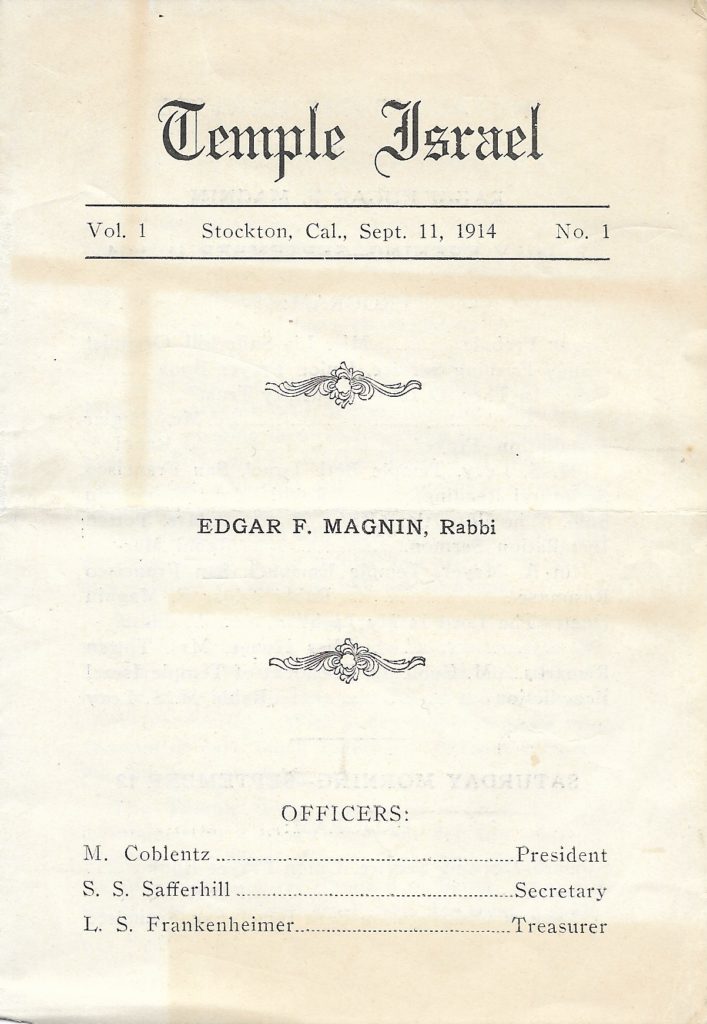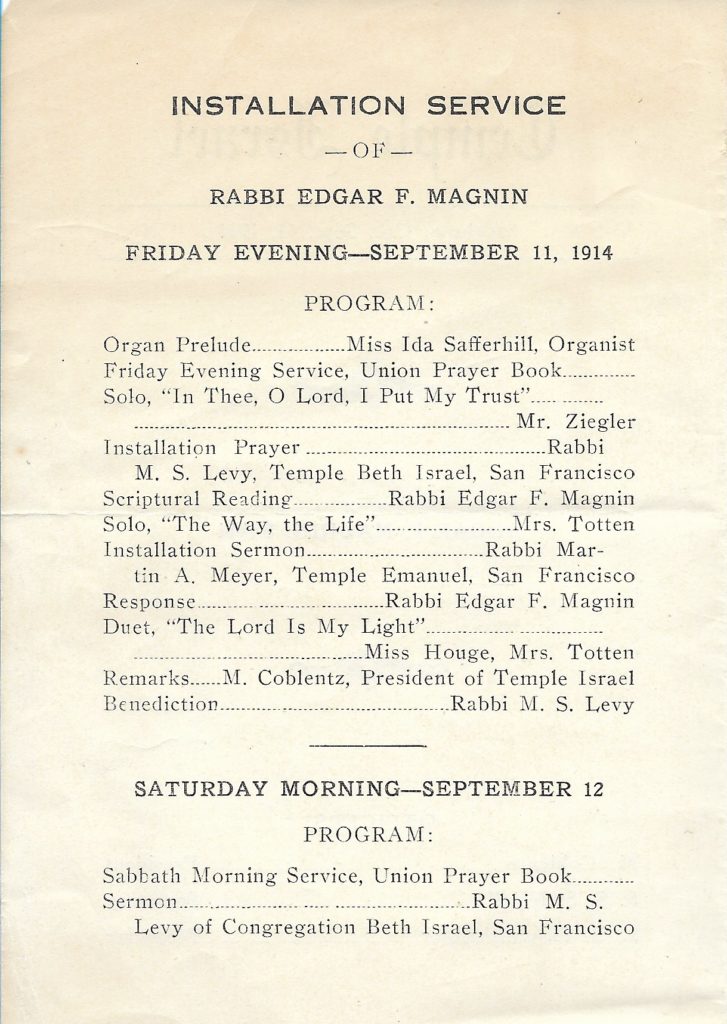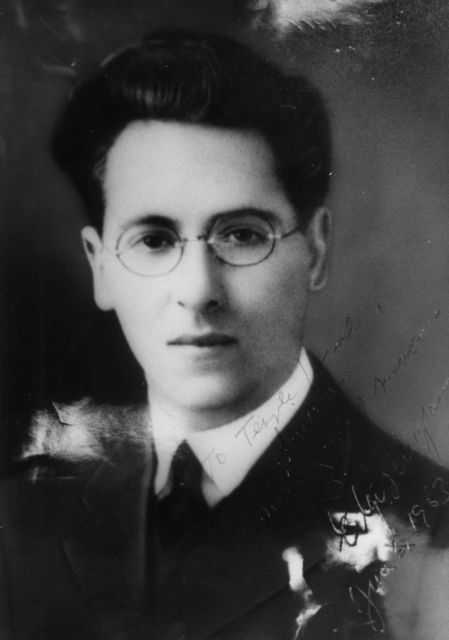Installation Service of Rabbi Edgar F. Magnin, Temple Israel of Stockton, 1914
Ryhim Ahoovim of Stockton, California (est.1851), later known as Temple Israel, struggled to retain rabbis during its early years. Even after erecting a new building on Hunter Street in 1904 and joining the Reform movement’s Union of American Hebrew Congregations in 1906, the congregation had difficulty attracting steady leadership.
Of the nine rabbis who served there between 1901 and 1929, only two of them, Louis J. Kopald and Emmanuel Jack, stayed for more than three years (they lasted four years each).
The board of trustees hoped things would change with the hiring of Rabbi Edgar F. Magnin, a young and charismatic recent graduate of Cincinnati’s Hebrew Union College.
A native of San Francisco, Edgar F. Magnin was born into a prosperous family in 1890. His grandparents, Mary Ann and Isaac Magnin, were the founders of I. Magnin, a luxury merchandise department store chain. According to his biographers, Edgar “was born, not with a silver spoon in his mouth, but with an entire silver service.”
Magnin served Temple Israel as a student rabbi during the 1913 High Holiday services. He returned after his ordination in 1914, but only stayed until the end of 1915 (fifteen months).
While serving briefly in Stockton, Rabbi Magnin visited Fresno to organize that city’s Temple Beth Israel. Shortly thereafter, he moved on to Congregation B’nai B’rith, Los Angeles, today’s Wilshire Boulevard Temple, where he served for an astonishing sixty-nine years until his death in 1984.
Rabbi Magnin’s tenure at Congregation B’nai B’rith/Wilshire Boulevard Temple began in 1915. He initially served as assistant rabbi to Rabbi Sigmund Hecht, and became the congregation’s senior rabbi in 1919.
In 1920, Rabbi Magnin led a well-heeled group in forming Hillcrest Country Club, which soon acquired a 142-acre plot near Beverly Hills. The club’s early membership included the city’s most prominent Jewish families, notably the Newmarks and Hellmans. Magnin was also a charter board member of the Hollywood Bowl (est. 1922).
Known as the “Rabbi to the Stars,” Magnin developed close ties with many in the motion picture and television industries. Throughout his long tenure in Los Angeles, he was also active in interfaith dialogue and civic affairs.
Installation Service Program

Installation Service Program for Rabbi Edgar F. Magnin, Temple Israel of Stockton, CA, 1914 (Western States Jewish History Association Archives)
Rabbi Edgar F. Magnin was installed as rabbi of Temple Israel of Stockton on Friday evening, September 11, 1914.
The installation service began with an organ prelude and a brief Shabbat service from the Union Prayer Book.
The remainder of the program comprised: an “installation prayer” delivered by Rabbi Myer Solomon Levy of Temple Beth Israel, San Francisco; a “scriptural reading” by Magnin; an “installation sermon” by Rabbi Martin A. Meyer of Temple Emanu-El, San Francisco; a “response” by Magnin; “remarks” by Meyer Coblenz, the Temple Israel’s president; a “benediction” by Rabbi Levy; and three English songs interspersed between the spoken presentations.
Temple Israel’s trustees had hoped that Magnin would stay with the congregation for many years, and that he would inspire members to become more engaged in Jewish and congregational life.
These goals were reflected in the program, which promoted Magnin’s first “Friday evening lecture,” dealing with the disconnect between many Jews and Judaism:
On Friday evening next, September 18th, Rabbi Edgar F. Magnin will deliver the first of a series of Friday evening lectures to extend throughout the winter. His subject will be “Idols, Old and New.” The lecture will deal with the problem of apathy and indifference that exists on the part of many Jews toward Judaism, and will enter into some of the underlying causes of the trouble and attempt to arrive at a solution of the evil. All are welcome.
Rabbi Magnin desires to express the pleasure that is his at making his home in your midst. He knows that you will co-operate with him and aid him in every matter that pertains to the betterment of the community. With your co-operation we may accomplish very much together, without it, nothing can be done at all.
The Temple is an institution erected by and maintained by a group of people for the adequate expression of their religious ideas and the furthering of a higher moral standard of living. It is not the private property of the Rabbi. He is but a guide, a leader, elected to represent his people in religious matters.

Installation Service Program for Rabbi Edgar F. Magnin, Temple Israel of Stockton, CA, 1914 (Western States Jewish History Association Archives)
Source
- William M. Kramer and Reva Clar, “Rabbi Edgar F. Magnin in Stockton, 1914-1915: Rehearsal for Los Angeles,” Western States Jewish History 17/2.
Jonathan Friedmann is curator for this Rabbi Magnin Installation Service exhibit.
